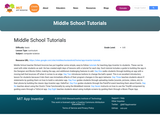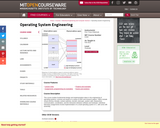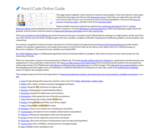
Interactive video reviewing list operations (arrays) and how they will be presented on the AP Exam.
- Subject:
- Applied Science
- Computer Science
- Material Type:
- Interactive
- Provider:
- Michigan Virtual
- Date Added:
- 12/11/2018

All resources in this collection have been identified by keyword Computer Science. If there are resources that should be included, please add this keyword to resources. We hope you find it valuable.

Interactive video reviewing list operations (arrays) and how they will be presented on the AP Exam.

Students will watch the video Banana, Banana, Meatball to introduce the concept of loops. Afterwards, they will identify loops in song lyrics and perform a deep dive into the importance using loops when programming.

The MITECS and Computer Science Standards Crosswalk resources provide a variety of activities for teachers to easily integrate the MITECS (Michigan Integrated Technology Competencies for Students) and Michigan Computer Science Standards into the K-8 classroom. They were created for all teachers who are interested in exploring ways to make connections between computer science and grade level curriculum content.

Deriving a symbolic description of the environment from an image. Understanding physics of image formation. Image analysis as an inversion problem. Binary image processing and filtering of images as preprocessing steps. Recovering shape, lightness, orientation, and motion. Using constraints to reduce the ambiguity. Photometric stereo and extended Gaussian sphere. Applications to robotics; intelligent interaction of machines with their environment. Machine Vision provides an intensive introduction to the process of generating a symbolic description of an environment from an image. Lectures describe the physics of image formation, motion vision, and recovering shapes from shading. Binary image processing and filtering are presented as preprocessing steps. Further topics include photogrammetry, object representation alignment, analog VLSI and computational vision. Applications to robotics and intelligent machine interaction are discussed.

This course covers elementary discrete mathematics for computer science and engineering. It emphasizes mathematical definitions and proofs as well as applicable methods. Topics include formal logic notation, proof methods; induction, well-ordering; sets, relations; elementary graph theory; integer congruences; asymptotic notation and growth of functions; permutations and combinations, counting principles; discrete probability. Further selected topics may also be covered, such as recursive definition and structural induction; state machines and invariants; recurrences; generating functions.

The focus of the course is on medical science and practice in the age of automation and the genome, both present and future. It includes an analysis of the computational needs of clinical medicine, a review systems and approaches that have been used to support those needs, and an examination of new technologies.

Presents the main concepts of decision analysis, artificial intelligence, and predictive model construction and evaluation in the specific context of medical applications. Emphasizes the advantages and disadvantages of using these methods in real-world systems and provides hands-on experience. Technical focus on decision analysis, knowledge-based systems (qualitative and quantitative), learning systems (including logistic regression, classification trees, neural networks), and techniques to evaluate the performance of such systems. Students produce a final project using the methods learned in the subject, based on actual clinical data. (Required for students in the Master's Program in Medical Informatics, but open to other graduate students and advanced undergraduates.)

Middle School teacher Richard Incorvia has put together some simple, easy-to-follow tutorials for teaching App Inventor to students. These can be used with older students as well. He has created eight days of lessons with a tutorial for each day. Each tutorial includes a guide to building the app in the Designer and Blocks Editor, making the app, and additional challenging features to add. Day One walks students through building an app with a moving ball that bounces off when it comes to an edge. Day Two introduces buttons to change the ball's speed. This is an excellent introductory lesson for students because it lets them see immediate effects of their program changes in the app's behavior. Day Three teaches students about if-statements by guiding them on how to build a calculator app. Day Four guides students through uploading media (sounds, pictures, videos, etc) to their phone by building the classic App Inventor app: HelloPurr. Day Five guides students through the PaintPot event teaching them about Events. Day Six teaches about using the Clock's Timer functionality by using the MoleMash tutorial. Day Seven instructs on how to use the TinyDB component by guiding users through a ToDoList app. Day Eight teaches students about using multiple screens by guiding them through a Music Player App.

Mobile Computer Science Principles (Mobile CSP) is an endorsed provider of the Advanced Placement Computer Science Principles (AP CSP) curriculum and professional development. Students learn computer science by building socially useful mobile apps. In addition to programming and computer science principles, the course is project-based and emphasizes writing, communication, collaboration, and creativity. A complete set of free, openly licensed, Mobile CSP curricular and instructional materials are available online. Developed and piloted at Trinity College, Mobile CSP is now also partnered with the College of St. Scholastica. Both are funded by the National Science Foundation. Since 2013 the Mobile CSP project has provided professional development to more than 400 teachers throughout the U.S. and reached more than 6,000 students. For 2017-18, there are more than 600 teachers and 10,000 students using the Mobile CSP curriculum.
The Mobile Computer Science Principles course (Mobile CSP) satisfies all requirements of the College Board's new AP Computer Science Principles course, which has been designed to help broaden participation in computer science among high school girls and underrepresented minorities. The Mobile CSP course uses the visual programming language, MIT App Inventor, to provide a rigorous, programming-based introduction to computer science using a project-based curriculum. Students learn computer science by building socially useful mobile apps. In this way, student learning will be associated closely with their interests and grounded in their schools, their homes, and their communities.

Teaching a course on App Inventor? This site provides a framework for doing so, based on the materials I've created and collected teaching App Inventor at the University of San Francisco. I've taught introductory CS for non-majors (CS0), but the materials could be adapted for a CS1 course for majors as well. You can also pick and choose from the seven available modules, or just give a two or three week intro to App Inventor with the introductory modules. The course-in-a-box includes:
Course framework
Lesson plans and lecture notes
Tutorials
Assigned readings (where to place chapters from the App Inventor book)
Conceptual worksheets
Screencast demos
Creative projects
Tests

Languages and compilers to exploit multithreaded parallelism. Implicit parallel programming using functional languages and their extensions. Higher-order functions, non-strictness, and polymorphism. Explicit parallel programming and nondeterminism. The lambda calculus and its variants. Term rewriting and operational semantics. Compiling multithreaded code for symmetric multiprocessors and clusters. Static analysis and compiler optimizations.

Computer-aided design methodologies for synthesis of multivariable feedback control systems. Performance and robustness trade-offs. Model-based compensators; Q-parameterization; ill-posed optimization problems; dynamic augmentation; linear-quadratic optimization of controllers; H-infinity controller design; Mu-synthesis; model and compensator simplification; nonlinear effects. Computer-aided (MATLAB) design homework using models of physical processes. This course uses computer-aided design methodologies for synthesis of multivariable feedback control systems. Topics covered include: performance and robustness trade-offs; model-based compensators; Q-parameterization; ill-posed optimization problems; dynamic augmentation; linear-quadratic optimization of controllers; H-infinity controller design; Mu-synthesis; model and compensator simplification; and nonlinear effects. The assignments for the course comprise of computer-aided (MATLABĺ¨) design problems.

In this unplugged activity, students are introduced to the concept of algorithms. They will use the Computer Programming video from Brainpop to prompt a discussion around giving directions and the value of iteration. Students will then engage by creating their own algorithm to help get their “robot teacher” from point A to point B.

Relationship between computer representation of knowledge and the structure of natural language. Emphasizes development of the analytical skills necessary to judge the computational implications of grammatical formalisms, and uses concrete examples to illustrate particular computational issues. Efficient parsing algorithms for context-free grammars; augmented transition network grammars. Question answering systems. Extensive laboratory work on building natural language processing systems. 6.863 is a laboratory-oriented course on the theory and practice of building computer systems for human language processing, with an emphasis on the linguistic, cognitive, and engineering foundations for understanding their design.

This course is a graduate subject in the theory and practice of network flows and its extensions. Network flow problems form a subclass of linear programming problems with applications to transportation, logistics, manufacturing, computer science, project management, and finance, as well as a number of other domains. This subject will survey some of the applications of network flows and focus on key special cases of network flow problems including the following: the shortest path problem, the maximum flow problem, the minimum cost flow problem, and the multi-commodity flow problem. We will also consider other extensions of network flow problems.

This course teaches the fundamentals of engineering operating systems. The following topics are studied in detail: virtual memory, kernel and user mode, system calls, threads, context switches, interrupts, interprocess communication, coordination of concurrent activities, and the interface between software and hardware. Most importantly, the interactions between these concepts are examined. The course is divided into two blocks; the first block introduces one operating system, UNIXĺ¨ v6, in detail. The second block of lectures covers important operating systems concepts invented after UNIXĺ¨ v6, which was introduced in 1976.

This course introduces the principal algorithms for linear, network, discrete, nonlinear, dynamic optimization and optimal control. Emphasis is on methodology and the underlying mathematical structures. Topics include the simplex method, network flow methods, branch and bound and cutting plane methods for discrete optimization, optimality conditions for nonlinear optimization, interior point methods for convex optimization, Newton's method, heuristic methods, and dynamic programming and optimal control methods.

This is an advanced interdisciplinary introduction to applied parallel computing on modern supercomputers. It has a hands-on emphasis on understanding the realities and myths of what is possible on the world's fastest machines. We will make prominent use of the Julia Language software project.

This page collects together useful reference materials and examples for using Pencil Code. These are materials for an educator to use.

In this manual we will show how to use Pencil Code to explore programming. Pencil Code is a free programming tool available at pencilcode.net. Pencil Code was developed by Google engineer David Bau together with his son Anthony Bau, with open-source contributions from many others.
This manual is intended for a high school, an introduction to programming course. Students 9th, 10th and possibly 11th graders would benefit from taking this course. An advanced 8th grade student could take this. A typical math pre-requisite of pre-algebra would be sufficient to take this course.